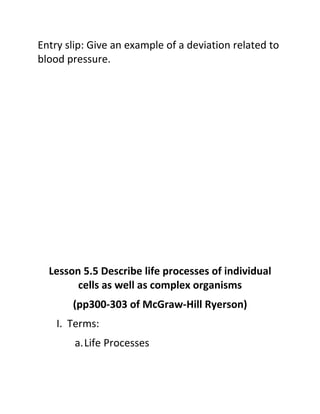
BIO30s 5_5_lifeprocesses
- 1. Entry slip: Give an example of a deviation related to blood pressure. Lesson 5.5 Describe life processes of individual cells as well as complex organisms (pp300-303 of McGraw-Hill Ryerson) I. Terms: a.Life Processes
- 2. i. Chemical reactions between tissues that keep an organism alive. b.Complex organism: an organism composed of more than one cell (i.e. a human). II. Life Processes: a.Closely involved in homeostasis, for the purpose of maintaining a person’s internal environment. b.Nervous System: i. (In terms of an individual) Cell: Nerve cells connect the body to the brain, and carry electronic signals between the two. ii. (In terms of the whole) Body: Network of nerves senses information from inside the body as well as the environment around the body. The brain then makes decisions and sends information to the effectors. c. Endocrine system:
- 3. i. Cell: Specific cells are affected by specific hormones. Some cells make and secrete hormones. ii. Body: this system secretes certain hormones into the bloodstream to be circulated around the body in order to give information/instructions to specific tissues and organs. d.Immune System: i. Cell: Some cells in the body are involved with immunity (WBC’s) and fight foreign pathogens. Most individual cells are by themselves defenceless against an attack. ii. Body: This system is responsible for defending cells from foreign pathogens as well as removing dead cells (pus). e.Digestive System: i. Cell: Receives nutrients from blood plasma by diffusion.
- 4. ii. Body: Obtains nutrients from external environment and transfers them to blood plasma for use and storage. Eliminates undigested food as waste. f. Transportation System: i. Cell: Receives nutrients and hormones, exchanges gases, and gets rid of wastes by diffusion with the circulatory system. ii. Body: “picks up” and “drops off” gases, nutrients, wastes and hormones at various areas. Also influences body temperature and immune response. g.Excretory System: i. Cell: Cells produce CO2 and nitrogen- containing wastes that have to be removed. ii. Body: removes N-containing wastes, excess water and minerals by
- 5. urination via the nephrons of the kidney. Exhales CO2 by the lungs. h.Respiratory System: i. Cell: Internal respiration (gas exchange between blood and cell); cellular respiration (gas exchange mainly in mitochondria of cells) by diffusion. ii. Body: Moves CO2 and O2 between atmosphere and individual cells, via the circulatory system. III. Youtube search: a.Nervous System-chinchin85 IV.Homework: a.Which life process is the most important? In other words, in the absence of which life process would the human body die the quickest? Why? b.-½ a page due next class.